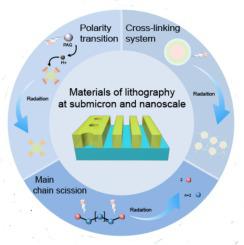The semiconductor industry has long been driven by advances in a nanofabrication technology known as lithography, and the fabrication of nanostructures on chips relies on an important coating, the photoresist layer. Photoresists are typically spin-coated to form a film and have a photolysis solubility transition and etch resistance that allow for rapid fabrication of nanostructures. As a result, photoresists have attracted great interest in both fundamental research and industrial applications. Currently, the semiconductor industry has entered the era of extreme ultraviolet lithography (EUVL) and expects photoresists to be able to fabricate sub-10 nm structures. In order to realize sub-10 nm nanofabrication, the development of photoresists faces several challenges in terms of sensitivity, etch resistance, and molecular size. In this paper, three types of lithographic mechanisms are reviewed to provide strategies for designing photoresists that can enable high-resolution nanofabrication. The discussion of the current state of the art in optical lithography is presented in depth. Practical applications of photoresists and related recent advances are summarized. Finally, the current achievements and remaining issues of photoresists are discussed and future research directions are envisioned.


